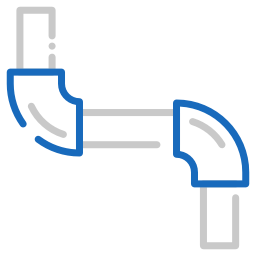Radon Mitigation/Pricing
Reduce High Levels of Radon in Your Building
Combination Radon Reduction Systems
If the home has a basement with multiple slabs, each area is mitigated separately with a sub slab depressurization system. If the home has multiple slabs that need to be mitigated, then each slab will be down drilled to create a suction pit. Schedule 40 PVC piping will be inserted into each suction pit. Piping from each suction pit will be connected together to create one complete system where multiple extraction points will be controlled with one radon fan. The fan can be positioned either outside or in the attic. See sub slab depressurization radon reduction system for a better description of a typical system.
Homes with a basement and crawl space will be mitigated in the same fashion as described above, the only difference is that the crawl space will be mitigated using a sub membrane depressurization system. Again, both systems will be tied together with schedule 40 PVC piping and controlled with one radon fan located on the exterior of the home or in the attic. See the active sub membrane depressurization system for a better description of this style of system.
If the home has a sump basin installed in the basement, then the basin can be used as an extraction point. The sump basin and sump pump will still serve its primary function to remove water from the basement, but it will be in combination with the radon reduction system to reduce radon in your home.
Pricing for these systems can vary between your home layout, and materials needed to perform the job. Call today for a free quote over the phone.
Active Soil Depressurization Radon Reduction System
If the home has elevated radon gas levels that has a crawl space, a specialized system is installed in these homes. The home will be mitigated by installing a strong puncture-resistant vapor barrier. The vapor barrier extends approximately a foot up on the foundation block line and piers. The vapor barrier is completely sealed to the block line and piers as well as any seams in the vapor barrier. This creates a barrier that traps the radon gas beneath the vapor barrier. To remove the radon gas from beneath the vapor barrier to eliminate any chance of it entering the home, suction is applied beneath the vapor barrier with a radon fan.
Slotted corrugated piping is strategically placed beneath the vapor barrier to capture and route Radon Gas away from the dwelling. Schedule 40 PVC piping is connected to the slotted corrugated piping and routed outside of the home or extended through the home to enter the attic where it would connect to a radon fan.
Pricing varies based on the square footage of the crawlspace that needs to be mitigated. Pricing can be anywhere from $1 to $2 per Square foot depending on height restrictions and conditions of the crawlspace.
The client would have the option to position the fan outside or in the attic. If the fan is positioned in the attic, piping would extend through the roof and exhaust a minimum of one foot above the roofline. All connections and penetrations through the sub flooring and roof would be properly sealed. This system can cost more than a typical sub slab depressurization system due to the cost of material, but this system will greatly reduce radon levels in your home.
Exterior or Interior systems
Systems located on the exterior of the home are placed in the most inconspicuous location as possible. Radon mitigation specialist works with the clients to place the system in desired locations. Exterior systems also come with the option to use downspout material to exhaust radon gas above the roof as opposed to scheduled 40 PVC piping. All connections are completely sealed off where no leakage would occur.
If the exterior system isn’t aesthetically pleasing for you and radon levels need to be reduced, there is another option to reduce radon levels. The system can be routed through the home from the extraction point, located in the basement or crawl space, all the way to the attic to attach to the fan and exhaust a minimum of 1 foot above the roofline.
Roof penetrations are properly sealed with a Kozy Collar and are guaranteed not to leak. Schedule 40 PVC piping is used throughout this style of system to route radon up and out of the home. The piping can be located in corners of closets, drop ceilings, or anywhere in the home that will connect all levels of the home. The radon mitigation specialist can give you all the options available on pipe routing while keeping the system as inconspicuous as possible. This style of system can cost more than an exterior system due to the construction of the home and difficulty of squeezing piping in tight corners. The advantage of this style of system is that it is unnoticeable from the exterior of the home.
Typical features you can expect with your radon reduction system
With the installation of your new radon reduction system, you can expect to see that each system is wired on their own dedicated breaker which is labeled in the panel box. Each system is also installed with an easy-read U-Tube manometer. The U-Tube is positioned near the extraction point where the homeowner can periodically check the system to assure that the system is operating as it should. Each system is also thoroughly labeled to prevent any tampering with the system.
The labeling includes the Contractor’s licensing information and contact information so the homeowner can call with any concerns or questions. All pipe connections and roof penetrations are properly sealed and will be leak-free. Systems will be covered under warranty for 5 years at no additional charge. Systems come with a free at-home test kit or can be tested by the licensed installer. Call today for a free, no-obligation quote over the phone.
